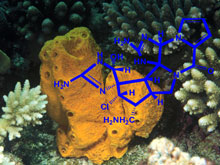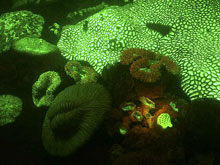
Drugs from the sea are one potential biotechnology product. The sponge Stylissa massa produces an unusual compound, palau-amine, with antimicrobial activity. Click image for larger view and image credit.
Fluorescent proteins in these corals have important biotechnology applications. Click image for larger view and image credit.
Marine Biotechnology
Marc Slattery
Chief Scientist – Cayman Islands Twilight Zone 2007
Department of Pharmacognosy
University of Mississippi
Biotechnology is defined as the industrial use of living organisms or biological techniques developed through basic research; marine biotechnology is an emerging discipline based on the use of marine natural resources.
The oceans encompass about 71% of the surface of our planet, but over 99% of the biosphere (since organisms are found throughout the water column), and they represent the greatest extremes of temperature, light, and pressure encountered by life. Adaptation to these harsh environments has led to a rich marine bio- and genetic-diversity with potential biotechnological applications related to drug discovery, environmental remediation, increasing seafood supply and safety, and developing new resources and industrial processes.
Drug Discovery and Marine-derived Compounds
Drug discovery represents one of the most promising and highly visible outcomes of marine biotechnology research. Biochemicals produced by marine invertebrates, algae, and bacteria are very different than those from related terrestrial organisms, and thus they offer great potential as new classes of medicines. To date, examples of marine-derived drugs include an antibiotic from a fungi, two closely related compounds from a sponge that treat cancer and the herpes virus, and a neurotoxin from a snail that has painkiller properties making it 10,000 times more potent than morphine but without the side effects.
However, there are several more marine-derived compounds currently in clinical trials, and it is likely that many more will advance to the clinic as scientists continue to look to the sea for these biotechnological uses. In addition to new medicines, other uses for marine-derived compounds include: cosmetics (algae, crustacean, and sea fan compounds), nutritional supplements (algae and fish compounds), artificial bone (corals), and industrial applications (fluorescent compounds from jellyfish, novel glues from mussels, and heat resistant enzymes from deep-sea bacteria).
Marine Biotechnology and Environmental Conservation
Biotechnology also holds the promise of increasing food supplies from the ocean; this is critical as overfishing and increased demand has taxed the limits of marine sustainable stocks. Aquaculture techniques have been enhanced by the discovery of natural inducers for spawning and larval settlement, as well as remediation of disease within culture facilities. Molecular genetic studies have also been applied to fisheries to identify natural populations and mixed stock interactions, and to estimate stocking efficiencies with pedigree.
More recently, biotechnology has been used to assess seafood safety through the development of novel test kits that react to the presence of human pathogens in the food. These "biosensor" techniques are currently being employed as early warning systems for environmental health. For example, harmful algal blooms and/or anthropogenic (created or caused by humans) toxins have the potential to cause great harm to marine habitats. Moreover, specific marine bacteria have been developed that can aid in the clean-up effort if a toxic spill should occur; thus biotechnology not only helps society, but it helps the environment as well.
Sign up for the Ocean Explorer E-mail Update List.




















